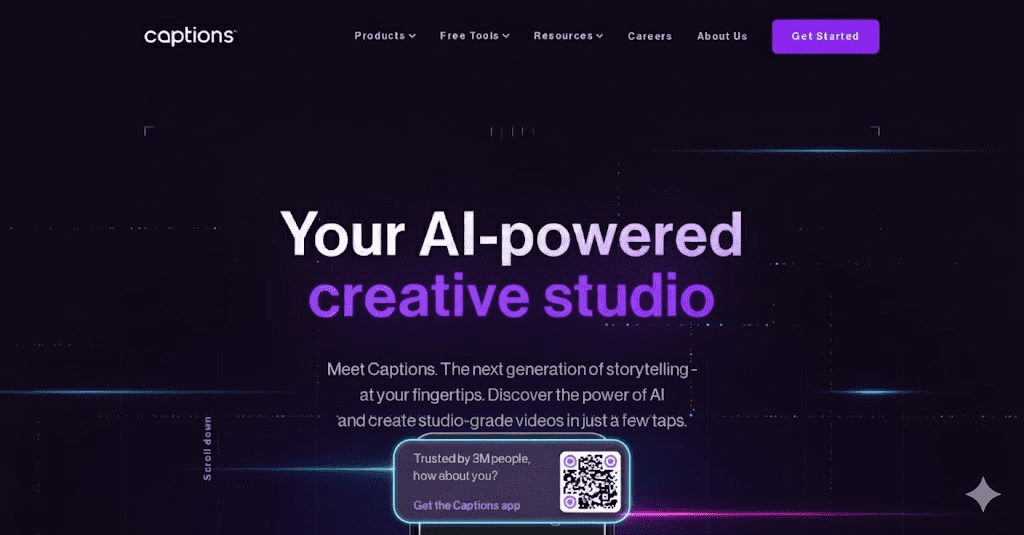The era of spending countless hours meticulously cutting footage in traditional software is over. If your content workflow still relies on manual, frame-by-frame adjustments, you are already operating at a severe disadvantage. In today’s digital environment, content velocity is the single most critical factor for success. Whether you are an independent creator striving to expand your audience or a business owner relying on content to drive customer acquisition, the demand for fast, high-quality output is relentless.
For too long, content creators faced an impossible bottleneck. Their choices were limited: either commit weeks to tedious self-editing, sacrificing time that should be spent on growth and strategy, or outsource the work and accept slow turnaround times and inconsistent quality. Editing became more than a cost; it became a massive drain on time and opportunities. The entire landscape has been fundamentally reshaped by artificial intelligence. The new wave of AI-powered editing tools has dramatically redefined both the speed and the quality of content production. The individuals and brands leveraging these tools are now generating exponential amounts of content, reaching wider audiences, and accelerating past competitors still bogged down by archaic methods. Crucially, these new systems are not the complicated, dense software suites of the past. They are intuitive AI editors that handle the heavy lifting, providing a simplified workspace while delivering astonishingly professional results.
To help you navigate this changing terrain, a comprehensive head-to-head comparison of the top four AI editing tools has been conducted. We will evaluate each platform based on four critical metrics, scoring each from one to five stars:
- Ease of Use and Core Features: How intuitive is the platform, and what essential capabilities does it offer?
- Content Repurposing Efficacy: How well and how quickly can the tool transform long-form source material into multiple short-form assets?
- Editing Capabilities and Quality: How deep and effective are the actual AI-powered editing functions?
- Value Proposition and Pricing: Is the subscription cost justified by the features and quality of the output?
Category 1: Ease of Use and Core Features
Understanding the fundamental workflow of an AI editor is the first step toward adoption. A tool that is simple to navigate and quick to learn drastically reduces the barrier to entry, allowing creators to focus on strategy rather than technical hurdles. This category evaluates the clarity of the interface and the accessibility of its main functions.
Captions.ai (Score: ⭐️⭐️⭐️⭐️⭐️)
Upon initial login to Captions.ai, users are met with a remarkably clean and simple setup. The primary workflow involves either describing the desired topic or uploading the source file. The left-hand navigation pane clearly displays the main features. While the platform offers advanced features like Mirage Studio and AI Creator for generating digital avatars (which are beyond the scope of this comparison), its core focus is immediately apparent: content editing and short-form creation. The dedicated AI editing tool allows for easy source file uploads, and the AI Shorts feature instantly generates clips from an uploaded file or a source URL. The overall design prioritizes a minimalist, intuitive experience. Although its feature set is somewhat limited compared to its competitors, its sheer ease of use earns it a perfect five out of five stars in this category.

Veed (Score: ⭐️⭐️⭐️⭐️)
Veed presents a more comprehensive, feature-rich interface. The workspace includes dedicated sections for templates, brand kits, and asset libraries, suggesting a tool built for high-volume content operations. Its central dashboard organizes the workflow around various AI “apps.” The AI Auto Editor is a straightforward function, requiring only minimal information about the desired final output before automatically processing the source material. The AI Clips feature is notably sophisticated, allowing for greater customization of the short-form assets it generates. Veed is undeniably a more complex tool than Captions.ai due to its depth and range of internal capabilities. However, its core editing and clipping functions remain highly usable and well-organized. For providing both usability and significant depth, Veed earns a solid four out of five stars.

Submagic (Score: ⭐️⭐️⭐️⭐️⭐️)
Submagic is designed with a clear, singular focus: content clipping and repurposing. The interface is highly specialized, offering distinct pathways for generating captions, creating multiple short clips, or using the “Magic Clips” feature for automatic extraction from longer content. Its primary editing tools are listed front and center—including B-roll generation, eye contact correction, audio cleaning, and caption translation. The simplicity of its specialized workflow means users can immediately jump into creating and editing repurposable assets without navigating a complex system. This straightforward, purpose-built interface warrants a full five out of five stars for ease of use.

Opus Clip (Score: ⭐️⭐️⭐️⭐️)
When logging into Opus Clip, the user is greeted by a clean, minimalistic design centered around core shortcuts: AI captions, editing, speech enhancement, reframing, B-roll, and the unique AI Hook feature. Opus Clip is highly versatile in its input, supporting numerous source URLs beyond the standard, including major platforms like YouTube and Twitch, in addition to direct file uploads. What truly distinguishes Opus Clip’s interface is the inclusion of integrated analytics and a calendar. Users can connect their social accounts to monitor content performance directly within the platform, allowing for data-driven adjustments. Furthermore, the scheduling calendar enables automated posting across platforms, representing a major time-saving capability. While the presence of many advanced features makes it slightly less simple than Captions.ai or Submagic, its seamless integration of creation and post-production analytics is highly valuable. For its power and integrated features, Opus Clip receives four out of five stars.

Initial Assessment Summary: Both Submagic and Captions.ai take the lead in this category due to their highly streamlined and simple user interfaces. This simplicity is a significant advantage for new users, though it hints at the limitations that will be explored in the next category: advanced editing capabilities.
Category 2: Editing Capabilities and Quality
The true measure of an AI editor is not just how quickly it performs a task, but how well it integrates sophisticated editing decisions. This category evaluates the depth of AI-powered features, the range of manual controls, and the professional quality of the final content output.
Captions.ai (Score: ⭐️⭐️)
Access to Captions.ai’s editing features is restricted to vertical-style source material; horizontal assets must be edited elsewhere. Once a video is uploaded and a template/color scheme is selected, the editing capabilities are minimal. The AI features are limited to generating supplementary assets (sounds, music, images) via prompting, or adding an AI-generated voiceover. Automatic tools include noise removal and eye contact correction. Beyond this, editing is mainly restricted to cutting or altering the subtitles. The platform functions more as a video templatizing tool—it applies a visual overlay—rather than a comprehensive editor. The final content output, while visually acceptable, lacks the depth and professional polish of a fully edited asset. Due to these significant editing limitations, Captions.ai scores two out of five stars.
Veed (Score: ⭐️⭐️⭐️⭐️)
Veed provides a significantly more robust editing environment, supporting both vertical and horizontal content formats. Its “Magic Tools” section is where the power lies: features include audio cleanup, automatic removal of filler words (like “ums” and “ahs”), silence removal, and “Magic B-rolls,” which automatically inserts contextually relevant images based on the spoken script. Other key tools are face appearance touch-up, eye contact fixing, background removal, green screen application, and “Magic Cut” for instantly removing unwanted takes and pauses. Veed’s strength is its solid foundation of core AI editing tools. The auto-subtitles are effective, and the final content looks professional and well-produced, having benefited from audio cleanup and B-roll integration. However, while good, Veed’s feature set is not exhaustive, leaving room for more advanced tools found in other platforms. Veed earns four out of five stars.

Submagic (Score: ⭐️⭐️⭐️🌗)
Submagic is a strong performer in this category, particularly for its specialized features, and it supports both vertical and horizontal content. Its interface highlights a clear transcription pane, where users can instantly remove silences and bad takes. The core AI tools are robust: “Magic B-rolls” insert both relevant stock images and supplementary footage, while “Magic Zooms” automatically apply dynamic zoom-in effects for engagement. After applying these effects and cleaning up the audio and eye contact, the final output is significantly improved from the raw source material, featuring polished subtitles and effective visual dynamics. The core issue, however, is the editing workflow itself. The formatting feels somewhat non-intuitive and less fluid compared to Veed, making the fine-tuning process slightly clunky. For strong AI features hampered by a less-than-ideal workflow, Submagic receives three and a half out of five stars.
Opus Clip (Score: ⭐️⭐️⭐️⭐️🌗)
Opus Clip excels in feature depth and output quality. Its editor supports a sophisticated tracker that intelligently follows the speaker’s face, ensuring they remain centered even when the original material was horizontal or the speaker moved within the frame. The AI Enhancement section is loaded with professional features: automatic removal of filler words and pauses, and a speech enhancement tool that drastically improves vocal clarity. The platform offers two B-roll options: “Autogenerate stock broll” (using a stock library) and “Autogenerate AI B-roll” (using generative AI). The latter, which was prioritized for this test, provided the most accurate and personalized results. A highly useful feature is the Autogenerate AI Hooks, which adds a natural, attention-grabbing voiceover to the clip’s beginning in the preferred language—a crucial tool for content without a strong opening. Combined with auto-emojis, auto-transitions (with easy visual previews and swap options), and a professionally styled subtitle system, Opus Clip produces content that rivals manually edited assets. The option to export as an XML file also allows for further refinement in professional editing software. For its comprehensive feature set, high quality, and integrated tools, Opus Clip earns four and a half out of five stars.

Editing Summary: Opus Clip edges out Veed due to the combination of its integrated features (like the AI Hook and superior B-roll generation) and the quality of the final, polished content, proving that AI can handle complex, professional-level editing decisions.
Category 3: Content Repurposing Efficacy
The ability to rapidly convert a single long-form source into dozens of short, high-impact assets is the primary driver of content velocity. This category assesses how efficiently and accurately each tool can extract the best segments, rate their viral potential, and provide tools for bulk distribution.
Note: All tools allow for further manual editing of generated short clips, which functions similarly to the primary editing features already reviewed. This section focuses on the quality and quantity of the initial AI-generated results.
Captions.ai (Score: ⭐️⭐️⭐️)
Captions.ai initiates repurposing via its “AI Shorts” feature, supporting only YouTube URLs or direct file uploads. After selecting an original language, template, and maximum clip length (30 seconds for this test), the platform generates a batch of short-form assets. The generation process is noticeably slow compared to its competitors. The final batch of five clips, while decent in appearance, lacked strong, distinct hooks across the board, and the platform offered no method for easily sorting or rating the clips based on potential performance. The absence of a performance rating system means users must manually review and judge the viral potential of each asset. Captions.ai receives three out of five stars—usable, but lacking the critical data-driven features needed for high-volume content operations.
Veed (Score: ⭐️⭐️⭐️)
Veed’s “AI Clips” feature is initiated by pasting the source URL and selecting a goal (e.g., “Viral Short”) and maximum length (15 seconds for this test). Veed provides an integrated rating system, scoring clips for factors like flow, hook, interest, and engagement, and listing them accordingly—a significant improvement over Captions.ai. However, the accuracy of this scoring is questionable. Many clips with high scores did not appear to have genuinely strong viral potential. While the interface for selection is intuitive, the low reliability of the scoring system prevents it from being a truly trustworthy feature for high-stakes content decisions. Veed also receives three out of five stars, as its rating feature failed to provide accurate, reliable value.
Submagic (Score: ⭐️⭐️⭐️⭐️)
Submagic uses its “Get Magic Clips” feature for repurposing, which is initiated by a source URL or file upload, followed by selecting language, duration, and caption theme. While the generated clips are of good quality with effective visual dynamics, a key drawback is the repetitiveness of the batch. Many clips were only slightly trimmed variations of the same segment, diminishing the value of generating a large volume of options. On the positive side, Submagic’s scoring system for clip viability was found to be more accurate and realistic than Veed’s, giving the user a better sense of which content to prioritize. For decent output quality and more accurate scoring, despite the occasional repetitiveness, Submagic is awarded four out of five stars.
Opus Clip (Score: ⭐️⭐️⭐️⭐️⭐️)
Opus Clip simplifies the repurposing process immensely, often initiating clip generation immediately upon pasting a URL on the homepage. Crucially, the platform avoids simply “spitting out a ton of clips randomly” by intelligently determining how many good clips can realistically be pulled from the source material, thus eliminating low-value duplicates. The platform provides a highly accurate viral score, which is derived from actual performance data integrated from its analytics feature. This makes the scoring system highly trustworthy for identifying genuine, high-potential hooks. In terms of both hook quality and clip variety, Opus Clip produced the strongest, most compelling set of short-form assets. Furthermore, the ability to instantly download, edit, or schedule posts with a single click across various platforms is a huge feature for maximizing content velocity. For its accurate scoring, high-quality results, and integrated distribution tools, Opus Clip earns a perfect five out of five stars.
Repurposing Summary: Opus Clip wins decisively in this category due to its combination of high-quality clip generation, a data-backed and accurate viral scoring system, and integrated scheduling, making it the most efficient tool for content acceleration.
Category 4: Value Proposition and Pricing
The final consideration is whether the cost of the tool is justified by the features, quality, and time savings it provides. This category assesses the tiered subscription model of each platform against the value delivered in the first three categories.
Captions.ai (Score: ⭐️⭐️)
Captions.ai offers a low entry-point plan at approximately $10 a month, but this tier is extremely limited, offering little more than access to different caption styles. The realistic starting point for a professional user is the higher-tier “Max” subscription at approximately $25 a month. Given that the tool’s core editing and repurposing features were found to be the most limited in the lineup, the pricing feels disproportionate to the actual value delivered. Captions.ai receives two out of five stars for a steep cost-to-feature ratio.
Veed (Score: ⭐️⭐️)
Veed primarily offers two plans: the “Light Plan” at approximately $20 a month, which removes the watermark and provides better upload flexibility, and the “Pro Plan” at approximately $50 a month. The Pro Plan is where users gain access to the most valuable features, including AI Clips and better export resolution, making it the practical necessity for leveraging the tool’s full potential. The cost is high for the features offered, especially compared to competitors that offer similar capabilities at lower price points. Veed is rated two out of five stars for its steep pricing structure.
Submagic (Score: ⭐️⭐️⭐️🌗)
Submagic’s starter plan is approximately $19, offering core features like no watermark, trimming, and API integrations. However, a major point of friction is that the essential “Magic Clips” add-on, which is the primary reason to use the tool, costs an additional $19. This places the total professional cost at approximately $38 a month. While Submagic delivered better content quality than Veed and Captions.ai, the necessity of paying an extra fee for a core feature makes the total cost slightly higher than ideal for the overall feature set. Submagic receives three and a half out of five stars.
Opus Clip (Score: ⭐️⭐️⭐️⭐️🌗)
Opus Clip provides one of the best value propositions. The “Starter Plan” at approximately $15 is a highly competitive entry point. The “Pro Plan,” priced around $29, is comparable to or lower than the starter plans of competitors, yet it grants users access to the platform’s full, high-end feature suite, including approximately 300 minutes of source material per month. The subscription is flexible, allowing users to easily double their capacity with extra credits rather than forcing an expensive jump to a higher tier. Given that Opus Clip delivered the highest quality results across the board, its flexible and aggressive pricing makes it a clear winner. Opus Clip receives four and a half out of five stars for exceptional value.
Conclusion: The Content Velocity Imperative
The data is conclusive: when comparing all four critical metrics—Ease of Use, Editing Capabilities, Repurposing Efficacy, and Value—Opus Clip clearly emerges as the leading AI content editing tool. It consistently scored highest, not just by a small margin, but across the most high-leverage features, including sophisticated B-roll generation, accurate viral scoring, and streamlined scheduling.
Understanding which tool to adopt is not merely a matter of saving time; it is a question of survival in the modern content ecosystem. The individuals and businesses who are currently thriving are those who can produce content faster without sacrificing quality, incurring massive editing costs, or facing the burnout associated with tedious manual labor. Consider the stark difference: a manual editor might deliver a handful of polished pieces a week. An AI power user, leveraging a tool like Opus Clip, can have 20 pieces of content generated, scheduled, and ready for distribution across multiple platforms in minutes, all filtered by trending topics and sorted by viral potential. That dramatic difference in content output is the gap between missing out on growth and revenue and successfully keeping pace with the rapid movement of the online world.
The AI editor is not just about time savings; it’s about exponential growth acceleration. By embracing an intelligent system, creators can post significantly more content, reach a wider audience faster, and achieve quicker growth without the traditional constraints of manual editing. The shift has happened. The time to upgrade your content workflow is now.






